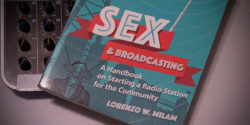I first learned of Lorenzo Milam because of his groundbreaking book, “Sex and Broadcasting.” Subtitled, “A Handbook on Starting a Radio Station for the Community,” it’s an idiosyncratic journey through the independent media landscape of the late 60s and early 70s. While it does serve as a handbook of sorts, as advertised, it’s a lot more fun and freewheeling than the mundane subtitle suggests.
Published in 1988, I first got my hands on a library copy around 1996, when a few years volunteering at community radio station WEFT-FM in Champaign, IL lit a fire in me to learn all I could about this media form. By then Milam had long retired from radio, and I never was able to meet or correspond with him, despite some furtive attempts around that same time.
When I first heard the name Lorenzo Milam he was referred to as the “Johnny Appleseed of Community Radio,” due to the fact that he helped to found a series of community radio stations, beginning with Seattle’s KRAB-FM in 1961, followed by KBOO-FM in Portland, OR. This loose network would come to be known as the “KRAB Nebula.”
Milam died in Puerto Escondido, Oaxaca, Mexico on July 21 19, aged 86 years. He had left radio by the 1980s. Anyone who has spent a decade or more in community radio can sympathize with how the stress of working with and around dozens of passionate, creative but sometimes ill-mannered broadcasters can wear you down. He went on to publish “The Fessenden Review,” an eclectic literary review, followed by the online “Ralph Magazine,” short for “The Review of Arts, Literature, Philosophy and the Humanities.”
“Rebels on the Air” author and Reason books editor Jesse Walker wrote a lovely obituary for Milam, calling on his interviews for that book, and the friendship that endured afterward.
ACORN founder Wade Rathke got to know Milam as he founded community station KCHU in Dallas, TX during the mid-70s. He shared some memories on his blog.
Madison, WI community station WORT-FM reports in their eulogy that Milam organized the first community radio conference, called NARK (National Alternative Radio Konvention) in that city in 1975 – less than five months before the station signed on.
It’s hard to imagine a single person who had greater influence on US community radio. My favorite aspect of his legacy is playfulness, and a willingness to experiment. While community radio has an important function to inform and provide a platform for voices still left out of mainstream media, revisiting “Sex and Broadcasting” reminds us that the enterprise should also be fun, and that we should also take the opportunity to thumb our noses at the powerful.



